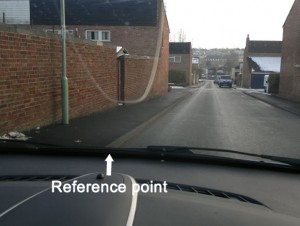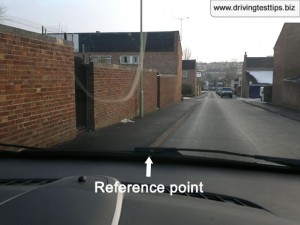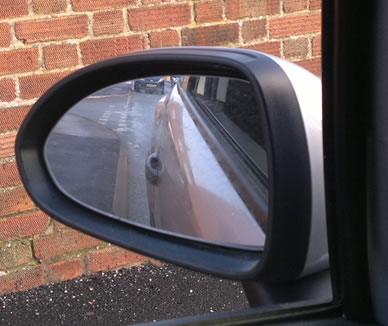Hitting the kerb (or ‘curb’ as it’s spelt in other areas) during a driving test is a concern for most learner drivers as it can result in a potential driving test failure. During the manoeuvres part of the driving test is by far the most common place that learners hit the kerb.
Hitting the kerb isn’t always quite as bad as you think. Driving examiners are human (mostly) and more often than not, actually want you to pass the test. This section will provide you with some tips and advice on the appropriate actions to take if you should hit the kerb during a driving test.
Hitting the kerb during a driving test
Generally speaking, hitting the kerb during a driving test is a big no no. From the examiners point of view it is classed as a lack of control. They look upon hitting the kerb as ‘If you hit the kerb, what else are you capable of hitting’.
The examiners have a set of rules in which to fail or pass driving test candidates. Outside of the set rules, they use their own judgment which is based on each individual examiner. Gently hitting a kerb for one examiner could be an immediate fail, for another a simple minor.
An example of a good driving examiner would be when they ask you to park up on the left and you knock the kerb, instead of failing you, they will ask you to park up more frequently during the test to establish if it is an isolated incident or a common fault of yours. If an isolated incident, they should pass you.
General driving and hitting the kerb
The key here is to acknowledge your mistakes. During a driving, whether driving in general or parking on the left, if you hit the kerb, acknowledge it verbally to the examiner. The worst possible situation is if you hit the kerb and the examiner thinks you are not even aware of it. By acknowledging it, you are making the examiner aware that you made an error, it’s an error you seldom make and that the rest of the test will not involve this error again.
This applies to any mistake you make during a driving test and not just hitting the kerb. Acknowledging can be the difference between a minor and failing. This does of course depend on the degree of harshness that you hit the kerb. A knock or brush against the kerb can be remedied by acknowledgment and correctness. Actually mounting the kerb and driving onto the pavement during general driving will most certainly result in a test failure.

Road positioning
If getting too close to the kerb whilst driving or hitting the kerb is an issue for you, use a reference point to help you establish a good distance from the road side. Whilst driving, ask your instructor or passenger to tell you when you have a good road position.
Then establish where the edge of the pavement, kerb or road line comes into the kerb and make a reference to where that is on the dashboard.
It’s a very similar reference point to parking on the left, but as you are further into the road, the reference point is slightly further to the left. You could use two small stickers for the road position reference point and for parking.
Hitting the kerb during manoeuvres
Driving test manoeuvres is by far the part of the test where the learner has the most control and the examiner is the most lenient (if you deal with it correctly). Hitting the kerb is also the part of the test that learners hit the kerb most frequently. Before a driving test, the most important action is to practice manoeuvres until you are completely confident and by sticking strictly to reference points that either your driving instructor has given you, or the reference points outlines in our manoeuvre tutorials. Straying from reference points can easily land you into the kerb.
If you do feel that you have overshot or strayed from a reference point during a test, quickly explain this to the examiner and tell them you need to move the car slightly to correct. There is a possibility of gaining a minor for this, but it’s far better than failing.
If it really does all go wrong and you find yourself hitting the kerb, all is not lost. Again as above, acknowledge your mistake and ask the examiner politely if you could try the manoeuvre again. The chances are they will let you.
Not too long ago, a learner was on their test and during the parallel parking manoeuvre, they hit the kerb 3 times. On the fourth attempt after the learner kept asking to try again, she completed the manoeuvre successfully and passed the driving test. Of course not every examiner will be this forgiving, but perseverance is an admiral quality that most people respect. So remember, acknowledge the error, tell the examiner it’s not an error you make frequently and if during a manoeuvre, ask to try again.
kerb reference points
Learner drivers are particularly vulnerable for hitting the kerb whilst parking up. If you are prone to hitting the kerb whilst parking, it may be beneficial to use some reference points to help you.

Reference point A
Establish a good parking position (your passenger can help with this) and sitting in your normal driving position, look at where the kerb comes into the car through the front windscreen. You can either remember this reference point or place a small sticker there.
Whilst driving and intending to park on the left, edge over to the left slowly, use this reference point to aid you in gaining the appropriate distance from the kerb whilst not hitting it.

Reference point B
Use another reference point to help you park. Whilst parked in a good position (ask your passenger or instructor to help with this), look into your left mirror and check the distance from the kerb and your car. Take a mental snapshot of this image.
Whilst parking on the left, use this reference point combined with reference point ‘B’ above whilst edging over to the left. These reference points used together will aid you considerably in parking.
Related Information
Below are manoeuvres taken during driving lessons and the driving test where hitting the kerb is easily done.

Good information keep t up
Thanks, Mutabera